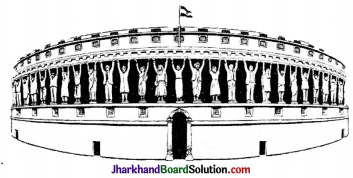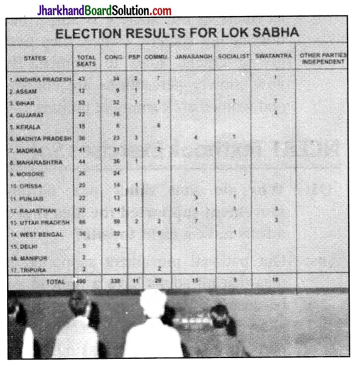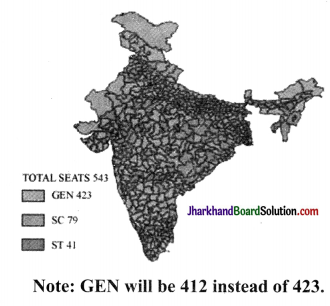JAC Board Class 7 Social Science Notes History Chapter 10 Eighteenth-Century Political Formations
→ In eighteenth century, the political conditions of India changed quite elaborately and within a relatively short span of time.
→ The Crisis of the Empire and the Later Mughals:
- During the closing years of the seventeenth century, the Mughal Empire started facing a variety of crisis after having huge success period. There were number of reasons for this crisis. Emperor Aurangzeb had depleted the military and financial resources of his empire by fighting a long war in the Deccan.
- It became very tough and difficult for the later Mughal emperors to keep a check and hold on their powerful mansabdars.
- They had exceptional political, economic and military powers over vast regions of the Mughal Empire. As the governors amalgamated their control over the provinces, the periodic remission of revenue to the capital declined.
- In many parts of northern and w estern India, peasants and zamindari rebellions also created these problems.
- In 1739, Nadir Shah, the ruler of Iran sacked and devastated the city of Delhi during the economic and political crisis, and took away huge amounts of wealth. Between 1748 and 1761, this invasion was followed by a series of ransacking raids by Ahmad Shah Abdali, the Afghan ruler w’ho invaded north India five times.
- The different groups of nobles were divided into two major groups — the Iranis and Turanis means nobles of Turkish descent.
- Mughal emperors w’ere humiliated a lot. Farrukh Siyar (1713-1719) and Alamgir II (1754-1759) were assassinated and two others Ahmad Shah (1748-1754) and Shah Alam II (1759-1816) were blinded by their nobles.
![]()
→ Emergence of New States:
- The Mughal Empire gradually disintegrated into a number of independent, regional states in the eighteenth century. These can be divided into three overlapping groups:
- The rulers of Awadh, Bengal and Hyderabad states did not break their formal ties with the Mughal emperor though extremely powerful and quite independent. These w’ere the old Mughal provinces.
- States such as several Rajput principalities that had enjoyed considerable independence under the Mughals as watan jagirs.
- The last group consists of states that were under the control of Marathas, Sikhs and others like the Jats. They had seized their independence from the Mughals after a long-drawn battle.
→ The Old Mughal Provinces:
- Among all the states in the old Mughal provinces, the three stand out strikingly.
- These were Hyderabad, Awadh and Bengal and founded by members of the high Mughal nobility who had been governors of these large provinces, Asaf Jah (Hyderabad), Sa‘adat Khan (Awadh) and Murshid Quli Khan (Bengal).
- Asaf Jah and Murshid Quli Khan held a zat rank of 7,000 each while Sa’adat Khan’s zat was 6,000.
→ Hyderabad:
- The founder of Hyderabad state, Nizam-ul- Mulk Asaf Jah (ruled 1724-1748), was one of the most powerful members at the court of the Mughal Emperor Farrukh Siyar.
- He ruled independently without seeking any direction or order from Delhi or without facing any interference however he was still a servant of the Mughal emperor.
- They were constantly engaged in war against the Marathas to the west and with independent Telugu warrior chiefs, Nayakas of the plateau. The desire was to control the rich textile-producing areas of the Coromandel coast in the east.
→ Awadh:
- In 1722, Burhan-ul-Mulk Sa‘adat Khan was appointed subadar of Awadh and founded the Awadh state.
- Burhan-ul-Mulk also held the important offices of subadari, diwani and faujdari. It means he was responsible for managing the political, financial and military affairs of the province of Awadh.
- He also tried to decrease Mughal influence in his region by reducing the number of officeholders i.e., jagirdars appointed by the Mughals and appointed his loyal servants to these vacant positions.
- The state sold the right to collect taxes to the highest bidders. These are called as ‘revenue farmers’ or ijaradars who agreed to pay the state a fixed sum of money.
- New social groups like moneylenders, bankers influenced the management of the state’s revenue system.
→ Bengal:
- Murshid Quli Khan was appointed as the naib means deputy to the governor of the province and was not a formal subedar. Bengal broke away from the Mughals under Murshid Quli Khan.
- He also had the hold of the revenue system similar to the rulers of Hyderabad and Awadh.
- He transferred all Mughal jagirdars to Orissa (now Odisha) and ordered a major reassessment of the revenues of Bengal to reduce Mughal influence there.
- The contiguous connection between the state and bankers was noticeable in Hyderabad and Awadh as well as in Bengal under the rule of Alivardi Khan (ruled 1740-1756).
- During his reign, Jagat Seth’s banking house became extremely prosperous.
![]()
→ Three common features of these states were:
- First, they were highly dubious of some of the administrative systems that they had inherited from the Mughals particularly in the jagirdari system.
- Second, they followed the practice of ijaradari means contracted with revenue-farmers for the collection of revenue.
- The third is very common feature in all these states was that their emerging relationship with rich bankers and merchants.
→ The Watan Jagirs of the Rajputs:
- In the eighteenth century, many Rajput kings had served under the Mughals with variation. In return, they were permitted to enjoy considerable autonomy in their watan jagirs. The ruler of Jodhpur, Ajit Singh was also involved in the sectional politics at the Mughal court.
- Raja Ajit Singh of Jodhpur was the governor of Gujarat and Sawai Raja Jai Singh of Amber was governor of Malwa. In 1713, these offices were renewed by Emperor Jahandar Shah.
- As they extended their watans or territories, Nagaur was conquered and annexed to the house of Jodhpur, whereas Amber seized large portions of Bundi. Sawai Raja Jai Singh founded his new capital at Jaipur and was given the subadari of Agra in 1722.
→ Seizing Indepedence: The Sikhs:
- Sikh organisation helped in regional state building in Punjab during seventeenth century. Guru Gobind Singh fought many battles against the Rajput and Mughal rulers both before and after the establishment of the Khalsa. The Khalsa rose in revolt against the Mughal power under Banda Bahadur’s leadership after Guru Gobind Singh’s death in 1708 and declared their monarch by striking coins in the name of Guru Nanak and Guru Gobind Singh, between the Sutlej and the Jamuna. Banda Bahadur was captured in 1715 and executed in 1716.
- The Sikhs organised themselves into a number of bands known as jathas and later on misls. Their combined forces were known as the dal khalsa means grand army.
- Rakhi was introduced as a system which offered protection to cultivators on the payment of a tax of 20 per cent of the produce.
- In the late eighteenth centuiy, the Sikh territories extended their rule from the Indus to the Jamuna but they were separated under different rulers. One of the powerful rulers was Maharaja Ranjit Singh who reunited these groups and established his capital at Lahore in 1799.
→ The Marathas:
- Another powerful regional kingdom was the Maratha kingdom who opposed to Mughal rule. With the support of powerful warrior families of Deshmukhs, Shivaji (1627-1680) established a stable kingdom.
- The backbone of the Maratha army was the groups of highly mobile, peasant pastoralists (kunbis).
- After Shivaji’s death, a family of Chitpavan Brahmanas served Shivaji’s successors as Peshwa or principal minister. The capital of the Maratha kingdom became Poona (now Pune).
- The Marathas developed a very successful military organisation under the Peshwas.
- The Maratha empire expanded in between 1720 and 1761. The Maratha king was acknowledged as the overlord of the entire Deccan peninsula by the 1730s and possessed the right to. levy chauth and sardeshmukhi in the entire region.
- The Maratha expanded their rule rapidly into Rajasthan and the Punjab in the north, Bengal and Orissa in the east and Karnataka and the Tamil and Telugu regions in the south, after attacking Delhi in 1737.
- During the third battle of Panipat in 1761, the rulers became hostile and didn’t supported the Marathas.
- Apart from strong military campaigns, the Marathas also developed an effective administrative system. Agriculture was uplifted and trade was also revived. This helped Maratha chiefs means sardars such as Sindhia of Gwalior, Gaekwad of Baroda and Bhonsle of Nagpur to utilize the resources to raise powerful and strong armies.
- New trade routes emerged within regions such as trade between Agra and Surat expanded to include Poona and Nagpur in the south and Lucknow and Allahabad in the east.
![]()
→ The Jats:
- During the late seventeenth and eighteenth centuries, the Jats consolidated their power and their leader, Churaman, had captured territories situated to the west of the city of Delhi. By the 1680s they had begun to rule the region between the two royal cities of Delhi and Agra.
- They were prosperous agriculturists and towns- such as Panipat and Ballabhgarh became important trading centres.
- The kingdom of Bharatpur emerged as a strong state under the rule of Suraj Mai. Many of the city’s notables took refuge there when Nadir Shah sacked Delhi in 1739.
- Nadir Shah’s son Jawahir Shah had a strong troops of 30,000 people, hired another 20,000 Maratha and 15,000 Sikh troops to fight the Mughals.
- The Bharatpur fort was built in a fairly traditional style but at Dig the Jats built an elaborate garden palace combining styles influenced by Amber and Agra.


